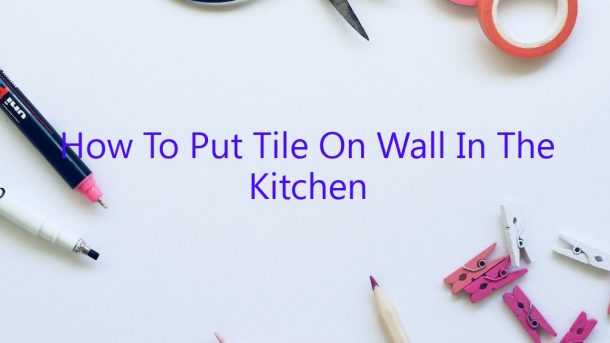Installing tile on a kitchen wall is a project that can be completed by most do-it-yourselfers. With a few basic tools and supplies, and a little bit of knowledge, you can have a beautiful tiled wall in your kitchen in no time.
The first step in installing tile on a kitchen wall is to measure the space and determine how much tile you will need. You will also need to purchase adhesive and grout, and any other supplies you may need such as a trowel, spacers, and a tile cutter.
Once you have all of your supplies, you can begin installing the tile. The first step is to apply adhesive to the wall. Be sure to read the instructions on the adhesive carefully, as different adhesives require different application techniques.
Once the adhesive is applied, you can begin installing the tile. Be sure to use spacers between the tiles to ensure that they are evenly spaced. Use a wet tile saw to cut tile if necessary.
Once the tile is installed, allow it to dry for 24 hours. Then, apply grout to the tiles. Be sure to read the instructions on the grout carefully, as different grouts require different application techniques.
Allow the grout to dry for 24 hours, and then enjoy your beautiful new kitchen wall!
Contents
How do you install tile on a kitchen wall?
Installing tile on a kitchen wall is a great way to add some character and durability to your kitchen. There are a few things you need to take into account before you start tiling, like the type of tile you want to use and the preparation of the wall. Here is a guide on how to install tile on a kitchen wall.
The first step is to decide on the type of tile you want to use. There are a variety of tiles available, including ceramic, porcelain, and stone. You will also need to decide on the size and shape of the tiles. Make sure to choose a tile that is durable and easy to clean.
The next step is to prepare the wall. The wall should be clean and free of dust and dirt. If the wall is painted, make sure to roughen up the surface with sandpaper so that the tile will stick to the wall. If the wall is covered in wallpaper, you will need to remove it before you can start tiling.
The next step is to mix the mortar. mortar is a mixture of sand, cement, and water. It is important to mix the mortar correctly, or it will not be strong enough to hold the tile in place. Follow the instructions on the package to mix the mortar.
Once the mortar is ready, you can start tiling. Start by applying a thin layer of mortar to the wall. Then, place the tiles in the desired position and press them firmly into the mortar. Make sure to leave a small space between the tiles to allow the mortar to cure properly.
Once the tiles are in place, you will need to wait for the mortar to cure. This usually takes 24 hours. Once the mortar is cured, you can apply a sealant to the tiles to protect them from stains and water damage.
Can you put tile directly on the wall?
Can you put tile directly on the wall?
It depends. If the wall is a solid surface, such as concrete, you can put tile directly on the wall. However, if the wall is a surface such as drywall, you will need to put down a layer of mortar before you can put tile on the wall.
Can you tile directly over painted drywall?
Tile is a popular flooring choice because it is durable and easy to clean. But can you tile directly over painted drywall? The answer is yes, but there are a few things you need to know first.
First, you should check the drywall for any damage. If the drywall is cracked or crumbling, you will need to repair it before tiling. Second, you should make sure the paint is in good condition. If the paint is peeling or bubbling, it will need to be removed before tiling.
Once the drywall is repaired and the paint is in good condition, you can begin tiling. Just make sure to use a thin-set mortar and a latex-modified thinset mortar for best results. Be sure to follow the manufacturer’s instructions for mixing and applying the mortar.
Once the mortar is applied, let it dry for 24 hours before installing the tiles. Be sure to use a tile cutter or a wet saw to cut the tiles to size. If you are using a mosaic tile, you can use a nipper to cut the tiles to size.
Once the tiles are installed, let them dry for 48 hours before grouting. Be sure to use a grout float to spread the grout over the tiles. Let the grout dry for 24 hours before sealing the tiles.
How do you apply tile to a wall?
Applying tile to a wall can be a daunting task for a beginner. However, with the right tools and knowledge, it can be a relatively easy project. This article will walk you through the process of tiling a wall.
The first step is to measure the wall and calculate how much tile you will need. You will need to purchase enough tile to cover the entire surface, plus a few extra tiles for mistakes.
Once you have the tile, you will need to prepare the surface. The wall should be clean and free of dust and dirt. If the wall is painted, you will need to remove the paint. The easiest way to do this is with a chemical paint remover.
If the wall is covered in wallpaper, you will need to remove the wallpaper. The easiest way to do this is with a wallpaper steamer.
Once the wall is clean and free of paint or wallpaper, you can begin tiling.
The first step is to mix the thin-set mortar according to the instructions on the package. Then, using a trowel, apply the thin-set mortar to the wall.
Next, place the tile in the mortar and press it firmly into place. Use a tile spacers to ensure that the tiles are evenly spaced.
Once the tile is in place, use a trowel to apply more thin-set mortar to the tile. Then, use a damp sponge to remove the excess mortar.
Allow the mortar to dry for 24 hours. Then, apply a grout sealant to the tile.
Allow the grout sealant to dry for 24 hours. then, you can apply a final coat of sealant to the wall.
When tiling a wall where do you start?
When it comes to tiling a wall, there are a few things you need to take into account before you start. The first thing to consider is where to start tiling. This will depend on the layout of the wall and the type of tile you are using.
If you are using a standard tile, you can start in the middle of the wall. If you are using a tile that is different from the others, you may want to start by tiling a small section at the bottom of the wall to create a border. You can then work your way up the wall.
When tiling a wall, it is important to make sure that the tiles are level. You can do this by using a level or a straight edge. You may also want to use a spirit level to make sure that the tiles are perpendicular to the floor.
If you are using a tile that is different from the others, you may want to start by tiling a small section at the bottom of the wall to create a border. You can then work your way up the wall.
Which tiles are best for kitchen walls?
When it comes to choosing tiles for your kitchen walls, there are a few things to consider. The first is the tone of your kitchen – are you going for a light and airy look, or a more cosy and traditional feel? The type of tiles you choose will play a part in achieving this look.
The second thing to consider is the practicality of the tiles. Kitchen walls can get dirty very easily, so you need tiles that are easy to clean. You also need tiles that are durable and will withstand the heat and moisture of a kitchen environment.
So, which tiles are best for kitchen walls? Here are a few options:
Porcelain tiles are a good option for kitchen walls. They are durable and easy to clean, and they come in a variety of colours and styles.
Ceramic tiles are also a good option for kitchen walls. They are durable and easy to clean, and they come in a variety of colours and styles.
Butterfly tiles are a good option for kitchen walls. They are durable and easy to clean, and they come in a variety of colours and styles.
Glass tiles are a good option for kitchen walls. They are durable and easy to clean, and they come in a variety of colours and styles.
Marble tiles are a good option for kitchen walls. They are durable and easy to clean, and they come in a variety of colours and styles.
So, which tiles are best for kitchen walls? It really depends on your individual needs and preferences. However, the above options are all good choices for kitchen walls.
Do you need to prime walls before tiling?
When it comes to tiling, there are a few things you need to do in order to ensure a successful installation. One of those things is to prime the walls. But do you need to prime walls before tiling? The answer is yes, you do.
Priming the walls before tiling is important for a few reasons. First of all, it helps to create a smooth surface for the tiles to adhere to. This is important, because if the tiles don’t adhere properly, they can eventually start to come loose. Secondly, priming the walls helps to prevent the tiles from staining the surface of the wall.
There are a few different ways to prime walls before tiling. One way is to use a primer specifically designed for this purpose. Another way is to use a coat of paint. If you choose to use paint, it’s important to make sure that it is a latex paint, and not an oil-based paint. Latex paint is water-based, which means it will be compatible with the adhesive that you’ll be using for the tiles. Oil-based paint, on the other hand, will not be compatible, and could cause the tiles to loosen up or even fall off the walls.
If you’re not sure whether or not your walls need to be primed before tiling, it’s best to err on the side of caution and go ahead and prime them. It’s a quick and easy process, and it will help to ensure that your tiles look their best and stay in place for a long time.




